
New Ways to Workshop: A Reading List to Inspire Literary Innovation
Rachel May and Krys Malcolm Belc Recommend Nicole Walker, Claudia Rankine, and More
In 2016, I was no longer interested in teaching the traditional workshop and felt that my students no longer wanted it. A poet mentioned that in their workshop, they read the poem on the spot and then discuss it together. This was mind-blowing. No reading and re-reading in the week before? No 500-word response letters to the writer? I felt the sky above me open, sunshine lighting the path to a workshop that might encourage more levity and play.
Another poet I’d talked to years ago told me about a conceit assignment that they do with their students (I cannot remember who this was—please let me know if you recognize the assignment so I can credit you!). The idea: Commit to writing poems around a single topic, idea, question, or theme, for the entire semester. This provides a constraint, which, as most writers know, can be both a great source of anxiety and creativity.
As a writer, I love a constraint; years ago, I had fun writing a series of linked CNF flash pieces one by one, every day, which I later fictionalized and wove through with found text. I’d seen my students produce some of their most miraculous work from short assignments, which often later became the central nuggets or jumping-off points for longer works.
So, when I was looking for ways to upend the workshop, I decided to design an undergrad course around a semester-long nonfiction short short/flash conceit that would become a chapbook. Students would choose a single subject around which to write all semester, workshop a “micro-essay”—inspired by Nicole Walker’s Micrograms—per class.
We’d read the pieces on the spot, and respond either to the writer’s questions or with what stood out as most compelling and powerful, in no more than six minutes per piece (the writer was always free to jump in as they liked). As we read during the semester, we’d study chapbooks as objects, thinking about design elements—paper choices, fonts, color, image+text pieces, etc. Students would revise and arrange their chapbooks in the second half of the semester, with the idea that they could choose to submit their creative nonfiction chapbook for publication. The next semester, I took this to my graduate students.
Krys Malcolm Belc was part of that first graduate class, wrote a chapbook in the class that went on to win the Cupboard’s contest, and began teaching a similar class this year in a six-week community workshop for Catapult. We chose some of our favorite reading assignments that inspire students and keep us all writing. Some of these are chapbooks, some are books that offer lessons we can apply to the chapbook and micro-essays/lyric essays/flash nonfiction—however you prefer to classify them… They’re all fantastic reads.
–Rachel May
*
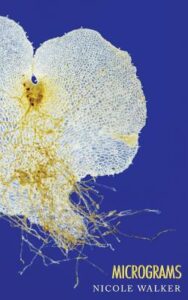
Micrograms by Nicole Walker
When I began designing the chapbook conceit class, this is the book that became my model. It’s a beautiful definition, in itself, of how a creative nonfiction conceit can work as a series of “micro-essays.” Walker focuses on my favorite themes: the environment, parenting, science, love, and her intense focus, like Lydia Davis’, is transfixing. You can’t look away. It’s like studying the world through, as David Lazar says, a microscope—but one with a vast, zoom-able view of the world. (Please also read the magnificent Egg and the new edition of Bending Genre, which is about books that fit neither here nor there and will delight you.)

The Persistence of the Bonyleg by Sarah Minor
This is another of my favorites to teach because of how students first find themselves flummoxed and then enamored. There’s a talking stump, the story is told in two columns with dialogue written like a script. It’s confusing, and delightful. After we start the chapbook, we watch a documentary about the Lykov family (who live in the remote Russian wilderness, undiscovered for decades), read an article about their history, and then students write their own “fairytale-essays,” with fabulist elements, in the same form as Minor’s. Students get really playful and start to challenge the edges of nonfiction, to find what creative nonfiction can do. This one is published and available free online (magical) by Essay Press; their chapbooks and books (especially Mary-Kim Arnold’s Litany for the Long Moment) have been so much fun to teach.
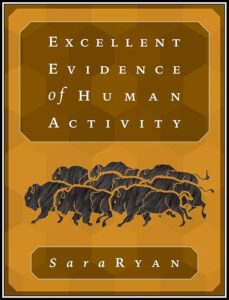
Excellent Evidence of Human Activity by Sara Ryan
Along with Walker’s Micrograms, I teach from this chapbook for two reasons: 1.) it’s good! and 2.) a lot of people who don’t read and write in poetry aren’t very familiar with chapbooks, which seem to be one of the best ways to highlight experiments that can’t go on for hundreds of pages. The Cupboard Pamphlet’s flash chapbooks are little and boxy and stylish and widely varied in their style and subject matter. Ryan’s work placing her millennial loneliness in the context of death and destruction of the earth is perfectly suited for the flash chapbook form.
[KMB] Back in 2016, Krys and Sara were students in that first graduate class I taught focusing on the semester-long micro-essays-as-chapbooks, so of course, it’s a joy to teach their work and have them talk with students about how to write a chapbook. I’m In Transit, Krys explores stories of transit that become metaphors for family, identity, transition, and the longings and triumphs translocation. And, I, too, love Sara’s language, which swirls around insects, death, destruction of the land, and other anthropocene themes that may be prose/may be poetry but are completely enticing.].

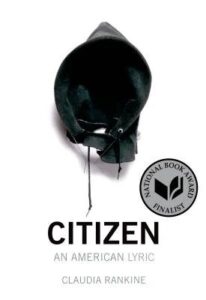
Don’t Let Me Be Lonely & Citizen by Claudia Rankine
These aren’t chapbooks, but they’re irresistible examples of how to weave together a book of nonfiction in shorts. Some people call them lyric book-length essay. Some call them poetry. No matter how you slice it, they’re brilliant books that will make you ask yourself about your relationships with family, language, and race in America. (Plus, I love how Claudia Rankine talks about image+text in Citizen in this great talk at the Woodberry Poetry Room.)
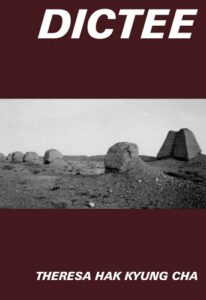
Dictée by Theresa Hak Kyoung-Cha
This book, like Rankine’s work, is groundbreaking and offers lessons with every reading. I’ve taught it for years, and many students at first resist the challenges its form offers—and then find themselves inspired. Kyoung-Cha writes in fragmented language that she weaves together to tell a story of immigration, her mother tongue and ancestors, and mythological figures including Persephone and Yu Guan Soon. Not so unlike our beloved Sebald, who would publish his most celebrated image+text books a decade after Dictee came out in 1982, Kyoung-Cha blends time and uses uncaptioned images to create a sense of endless story-time.
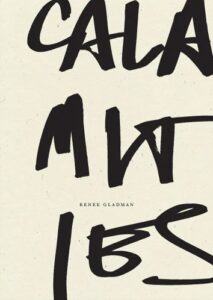
Calamities by Renee Gladman
This Renee Gladman essay collection is weird, hypnotic, speculative, and repetitive in a way that I hope can give writers a sense of writing momentum. Each of the essays begins, “I began the day,” and takes off in a direction no reader could predict. In an interview with Lucy Ives, Gladman called the essays “ditties”: “I call them ditties because they feel less like they’re trying to travel; there is just one point that gets made in a quick circle.” Flash collections have a powerful chance to push against the narrative impulse and this book is a great example of work that circles around and around.
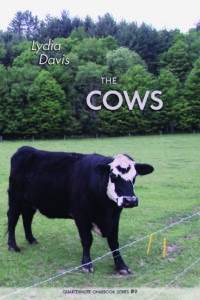
The Cows by Lydia Davis
Lydia Davis is one of our contemporary flash elders–a master of the form (and a bonafide genius). So, I have to include her work whenever I teach the nonfiction conceit class (please also read her longer collections of shorts). This chapbook is funny and odd and everything you’d expect from Lydia Davis’ piercing observations of the world around her–language boiled into tiny crystalline rainbow-makers.
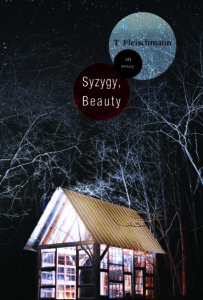
Sygyzy, Beauty: An Essay by T. Fleischman
This already seems like a classic. I love it because of how Fleischman wrangles the address of a lover into a series of flashes, so that it becomes a portrait of the speaker. That trick of focus reminds me a lot of Jenny Boully’s The Body: An Essay, which is a small volume written in footnotes. The white space of the page is tantalizing, and maybe where the truth of the love story she’s telling lies.
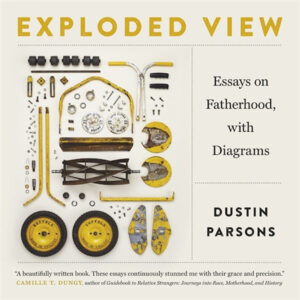
Exploded View: Essays on Fatherhood, with Diagrams by Dustin Parsons
This collection is really nice for students to encounter because while many of the essays are about childhood memories growing up as the son of an oilfield mechanic, others are very much grounded in the “dailyness” of Parsons’s present-day life as a partner and father. It’s a visually unusual book. Parsons uses everything from schematics to hand-drawn images to support his essays. I have a lot of luck teaching his craft essay “Dustin Parsons on Dropping Off”–which shows and cites his essay “Drop Off.”

Excerpts from Bluets & Jane, A Murder by Maggie Nelson
We always look at least an excerpt from Bluets and often from Jane, as well. I read Jane, then became completely engrossed when I read The Red Parts. That pairing of books is such a cool example of what can happen when a writer keeps moving with a subject that’s under transformation–the investigation of her aunt’s murder, the trial, and Nelson’s understanding of her aunt as a person and her family’s various responses to the murder. It’s like looking at a single subject through a kaleidoscope of archives, essays, and memories.
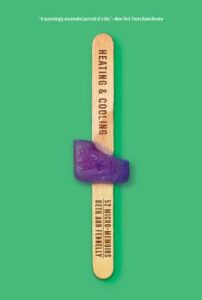
Heating and Cooling: 52 Micro-Memoirs by Beth Ann Fennelly
This is a standard-bearer in the genre for me. I like it because Fennelly is quite funny, and my syllabi tend to be pretty grim. The book’s 52 flashes have amazing range, but humor is so present in the book. It can be helpful for students—and me—to experience joy in reading this work. At the same time, there are some essays in it—like “I Survived the Blizzard of ’79”—that teache a lot about poignancy, and setting, and writing about memory. And I teach “11. And I’ve Been Searching Ceaselessly For You Ever Since, Mon Amor” along with other list essays to help students see what possibility exists in that kind of writing. And in this Electric Literature interview, Fennelly offers insight for writers looking to compile similar books:
“An early draft of the book had 100 pieces. My editor suggested I cut it down, not because any of the micro-memoirs were huge pieces of garbage, but because the book felt a little overwhelming. So I cut down pieces that seemed like outliers, thematically. I kept ones that focused on my central roles — wife, mother, writer, woman — and hoped the cuts allowed a kind of coalescing among these central roles. The book is in some ways about the choices we make in an effort to be happy.”
Online: Flash is largely an online world, in my experience both reading and writing it. There are a number of flash writers I read and follow regularly–like Dina Relles and jj peña–so if I am teaching a class with a wide variety of flash, I might rely on those writers’ works as well as some of the essays I’ve collected over the years that I think hold a lot of complexity and craft considerations for students trying to learn to write short essays–like “There Are Distances Between Us” by Roxane Gay, “I hoisted them, two drug dealers, I guess that’s what they were,” by Diane Seuss, and “Snowbound” by Natalie Lima.
Rachel May and Krys Malcolm Belc
Rachel May is the author of four books, most recently, An American Quilt: Unfolding a Story of Family & Slavery. Her work has recently appeared or is forthcoming in The New York Times, National Geographic, Outside, Guernica, Condé Nast Traveler, The Millions, Assay: A Journal of Nonfiction Studies, The Volta, among others. She's been a resident and fellow at The Vermont Studio Center, the VCCA, and The Millay Colony.
Krys Malcolm Belc Transmasculine essayist/dad/teacher/baker. Author of the memoir The Natural Mother of the Child, a New York Times “New and Noteworthy” title and NPR Best Book of 2021.



















